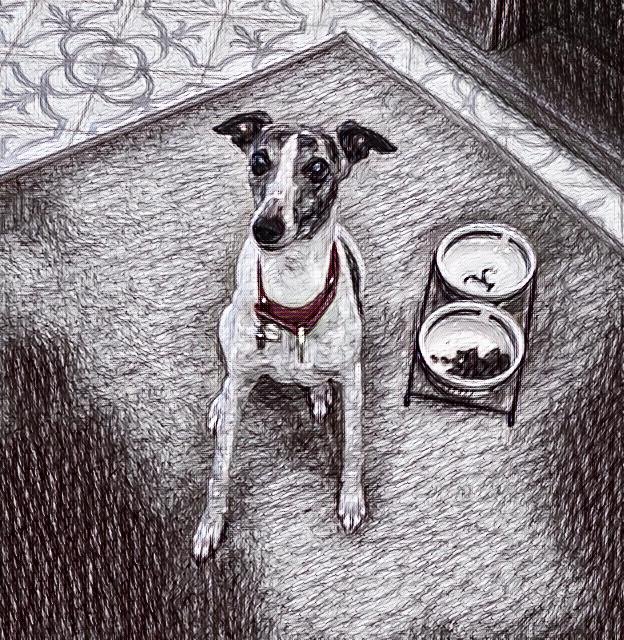Do you have a whippety question? Enter here your query or keyword.
- Home
- Whippet Puppies
- Best Food for Whippet Puppy
Best Food for Whippet Puppy: A Complete Guide to Healthy Beginnings
Find out what makes the best food for whippet puppy and how to make smart choices for your newest family member.
Bringing a whippet puppy into your home is an exciting experience filled with energy, affection, and the joyful chaos of puppyhood. As sleek, graceful, and intelligent as they are, whippets are also a sensitive breed—especially when it comes to nutrition.
Feeding your puppy properly during these early stages is one of the most important things you can do to ensure a strong foundation for their health and development.

Start With What the Breeder Recommends
When you first pick up your whippet puppy, the breeder will likely give you a sample of the food your puppy has been eating. This isn’t just a thoughtful gesture—it plays a vital role in your puppy’s transition to a new home. Sticking to the same food during the first few days helps avoid digestive upset while your puppy adjusts to new sights, smells, and routines.
Even if you plan to change foods eventually, it’s essential to introduce any new diet gradually. Puppies have delicate digestive systems, and sudden dietary changes can lead to upset stomachs, diarrhea, or vomiting. A good rule of thumb is to mix the new food in with the old over the course of 7–10 days, slowly increasing the ratio of new to old until the transition is complete. This thoughtful approach helps ease the shift and supports a healthy gut.
What Makes the Best Food for Whippet Puppy?
To support optimal growth, your puppy's food should be designed specifically for puppies and include balanced levels of protein, fat, vitamins, and minerals. Here’s a closer look at the key components that make up a nutritionally complete diet:
1. High-Quality Protein
Protein is the cornerstone of a puppy’s development. It helps build strong muscles, supports organ function, and provides the building blocks for healthy skin and coat. Look for foods that use whole animal proteins, such as chicken, turkey, lamb, or fish. These are more digestible and nutritionally dense than by-products or unnamed meat meals.
2. Moderate Fat Content
Fat is essential for energy and development. For an active breed like the whippet, fat plays a crucial role in fueling daily activities and supporting brain development. However, since whippets are naturally lean, their food should offer moderate fat levels to avoid excess weight gain.
3. Balanced Calcium and Phosphorus
Puppies need the right ratio of calcium and phosphorus to develop strong bones and teeth. Too much or too little of either can result in skeletal issues, especially in a breed with such fine bone structure. The correct ratio ensures bones grow at a healthy rate while maintaining proper density.
4. Digestible Carbohydrates
While not the main focus of a puppy’s diet, carbohydrates provide additional energy and fiber. Whole grains like brown rice or oats, and alternative sources like sweet potatoes, are gentle on the digestive system and support healthy bowel function.
5. Essential Vitamins and Minerals
Micronutrients play a massive role in everything from immune function to skin and coat health. Look for a balanced puppy formula that includes vital nutrients like vitamin A, vitamin D, zinc, iron, and omega fatty acids. DHA, in particular, is a beneficial omega-3 that supports brain and vision development in puppies.
6. Avoid Artificial Additives
Artificial preservatives, flavors, and colors have no nutritional value and may trigger allergies or sensitivities in puppies. The best food for whippet puppy will be free of unnecessary fillers or synthetic ingredients and focus instead on whole-food nutrition.

Feeding Schedule and Portion Control
Feeding your whippet puppy consistently is just as important as what you feed them. From 8 weeks to about 6 months, most puppies should be fed three to four small meals per day. After that, you can typically transition to two meals daily as they grow older.
Portion control is key. Overfeeding a whippet puppy can result in excess fat accumulation, which can stress developing joints and bones. Always follow the feeding guidelines on your chosen food, but be ready to adjust based on your puppy’s energy level, weight, and growth rate.
Keep an eye on their body condition—a puppy should have a visible waist and you should be able to feel (but not see) their ribs.
Signs of a Healthy Diet
So how do you know if your puppy is thriving on their current food? There are several positive signs to look for:
- Consistent, firm stools
- Steady growth and healthy weight gain
- Bright eyes and a shiny coat
- High energy levels
- Good appetite and regular eating habits
On the other hand, if your puppy has frequent digestive upset, itchy skin, or seems uninterested in eating, it may be time to evaluate their food. Consult your veterinarian if any issues persist—they may recommend a change in diet or additional tests to rule out allergies or sensitivities.
Gradually Evolving Nutritional Needs
As your whippet grows, their nutritional needs will shift. Puppies typically complete their growth between 12 and 14 months of age, at which point they’re ready to transition to adult food. As with the initial switch from the breeder’s food, this change should be made slowly and carefully to maintain digestive health.
Even in adulthood, whippets remain sensitive eaters. The habits and preferences formed during puppyhood often carry forward, so starting with the best food for whippet puppy can help set a positive pattern that lasts a lifetime.
Check out here how to feed your adult whippet
A Thoughtful Start Sets the Tone
Your whippet puppy depends on you to provide the right nutrition, care, and consistency to help them grow into a confident and healthy adult. By starting with the food recommended by your breeder and transitioning thoughtfully to a balanced, high-quality diet, you're giving your pup the best possible start in life.
Remember, there is no one-size-fits-all answer when it comes to choosing the best food for whippet puppy. Each dog is unique, and what works for one may not work for another. With a little research, patience, and guidance from your vet, you’ll find the perfect match for your puppy’s needs.
In the end, the food you choose plays a big role in your whippet's lifelong health—and there's no better time to start making great choices than right now.



